Beluga Caviar Market Research, 2032
The global beluga caviar market size was valued at $108.4 million in 2022, and is projected to reach $179.4 million by 2032, growing at a CAGR of 5.1% from 2023 to 2032.
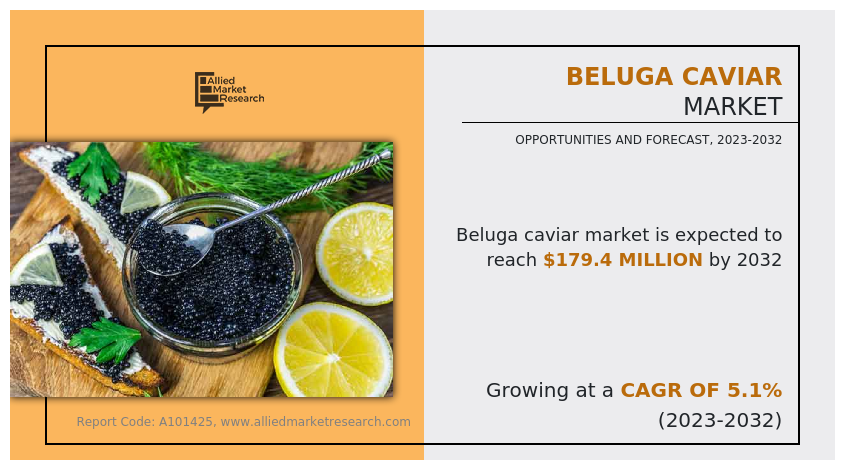
Market Overview
Beluga caviar represents one of the globe's most valuable and costly forms of caviar. It originates from the Caspian Sea region's native beluga sturgeon, referred to as Huso huso. Beluga caviar is recognized for its enormous, strong, and exquisite eggs that range in color from light grey to dark grey and have a buttery, nutty flavor. Beluga caviar, generally regarded as the pinnacle of luxury and pleasure, commands a significant share of the worldwide gourmet food industry. This cherished delicacy is made from the spawn of beluga sturgeons (Huso huso) and is known for its excellent flavor, delicate consistency, and notably big and lustrous pearls.
Over the years, the market has seen tremendous expansion and demand, driven by a variety of variables that have impacted its trajectory. Connoisseurs and gourmet food enthusiasts all around the world seek Beluga caviar because of its remarkable flavor and scarcity. A range of variables influence the beluga caviar market, driving, impeding, and creating chances for growth. A rise in demand for premium and gourmet food items throughout the world is predicted to boost market growth. As disposable incomes rise and lifestyles change, consumers are ready to invest their earnings in high-end food, especially the consumption of luxury delicacies such as beluga caviar. The exclusivity and grandeur associated with beluga caviar fueled its appeal, especially with the wealthy and social elite who see it as a mark of quality and taste.
COVID-19 had a negative impact on the beluga caviar market as all the commercial places were shut down during the pandemic. For instance, according to the report of the European Commission, the COVID-19 pandemic had a strong impact on the caviar market. As the HoReCa segment was largely shut down alongside a dramatic reduction in airline and cruise ship travel, many of the traditional market outlets for caviar disappeared. As the HoReCa segment closed, many of the traditional caviar customers adapted. Previously, restaurants would buy caviar in tins of 120 grams or 250 grams and split the caviar into multiple meal servings. As restaurants began to offer takeaway options, they shifted their purchases away from larger caviar tins and, in place, increased their purchase of smaller 30 grams tins, which could be sent out with takeaway meals.
Given the growing interest in environmentally friendly and sustainable food choices, consumer preference for beluga caviar is expected to rise throughout the forecast period. Beluga caviar is derived from the roe of the beluga sturgeon, which is found mostly in the Mediterranean and Black Seas. Nonetheless, the beluga sturgeon populations has declined owing to overfishing and illegal activities that have put them in danger. To address this environmental concern, more stringent measures in the harvesting and trade of beluga caviar have been introduced by regulators and protectionist groups, resulting in a limited supply. Consequently, the scarcity of beluga caviar caused an upsurge in prices and further increased demand for this luxury food item. Furthermore, the beluga caviar market has been provided with significant development potential as demand for premium dining experiences has increased, particularly in emerging nations. With increasing disposable earnings and an expanding middle class in nations such as China, India, and Brazil, there is an increase in appetites for distinctive and lavish culinary offerings. This tendency has prepared the path for beluga caviar to enter new markets, drawing a larger client base and contributing to the overall market's growth.
However, several factors restrain the beluga caviar market growth. Firstly, the high price of beluga caviar makes it unaffordable for a large portion of the population. The rarity and labor-intensive process of obtaining beluga caviar results in premium pricing, limiting its accessibility to only a niche segment of consumers. Moreover, the stringent regulations and legal framework surrounding the harvesting, export, and import of beluga caviar impose additional challenges for market growth. These laws are intended to conserve endangered sturgeon species, but they also restrict the supply and sale of beluga caviar. Nonetheless, the industry is evolving and creating new prospects for growth. The establishment of sustainable aquaculture practices is one such possibility. With the number of wild beluga sturgeons declining, there has been a turn towards sturgeon cultivation to supply caviar demand. Sustainable aquaculture techniques might help to relieve the strain placed on wild sturgeon populations while also assuring an ongoing supply of excellent beluga caviar. This approach not only addresses ecological concerns but also presents a lucrative opportunity for market players to expand their production capacity and cater to the growing demand.
In addition, advancements in technology and logistics have opened new avenues for the beluga caviar industry. Cold chain logistics and improved transportation networks have made it easier to distribute beluga caviar globally while maintaining its quality and freshness. E-commerce platforms and online marketplaces have played a significant role in expanding the reach of beluga caviar, allowing consumers from various regions to access and purchase this luxury food item conveniently.
In conclusion, the beluga caviar market is driven by factors such as an increase in demand for luxury food, the appeal of sustainable & eco-friendly options, and the growth of high-end dining experiences in emerging economies. However, the market faces constraints due to its high price and stringent regulations. However, chances for expansion remain due to the growth of sustainable aquaculture practices as well as advances in technology and logistics. As the industry adapts and evolves, consumer interest in beluga caviar is projected to stay robust among those looking for a premium and one-of-a-kind gourmet experience.
Segmental Overview
For the beluga caviar the market is segmented into form, application, distribution channel, and region. On the basis of form, the market is bifurcated into fresh and processed. By application, the market is divided into hotels & restaurants and household. On the basis of distribution channel, the beluga caviar market is classified into direct and indirect. Region-wise the market is analyzed across North America (U.S., Canada, and Mexico), Europe (UK, Germany, France, Italy, Spain, and the rest of Europe), Asia-Pacific (China, Japan, India, Australia, and the rest of Asia-Pacific) and LAMEA (Latin America, Middle East, and Africa).
By Form
On the basis of form, the market is segmented into fresh and frozen segments. The fresh segment accounted for the majority of the share of the market in 2022 and is expected to maintain its dominance during the forecast period owing to its unique and complex flavor profile. As disposable income increases and consumer preferences shift toward high-quality culinary experiences, demand for fresh beluga caviar is expected to increase. Moreover, the demand for fresh beluga caviar has increased due to increased tourism and research on a vast variety of gastronomic experiences.
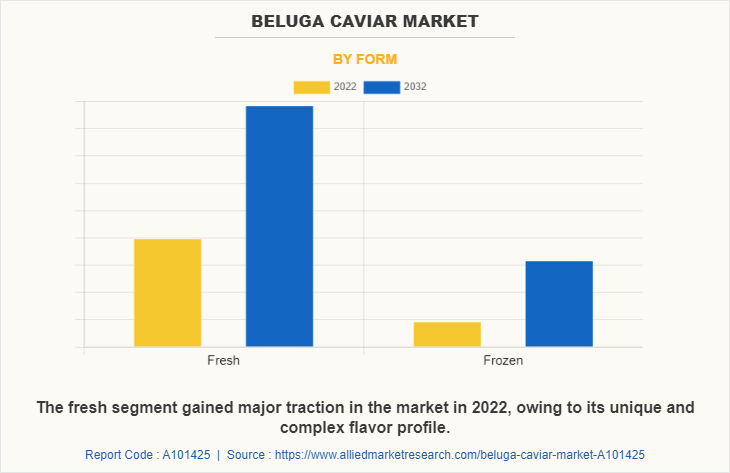
By Application
On the basis of application, the market is classified into hotels & restaurants and household segments. The hotels & restaurants segment dominated the market in 2022 and is expected to maintain its dominance during the forecast period since it is highly valued for its luxurious appeal and ability to elevate dining experiences. Beluga caviar’s increased application in the HoReCa sector is supported by an evolving gastronomic landscape and the rise in popularity of food. Innovative ways of incorporating top-quality ingredients into their recipes are always being explored by chefs and culinary professionals.
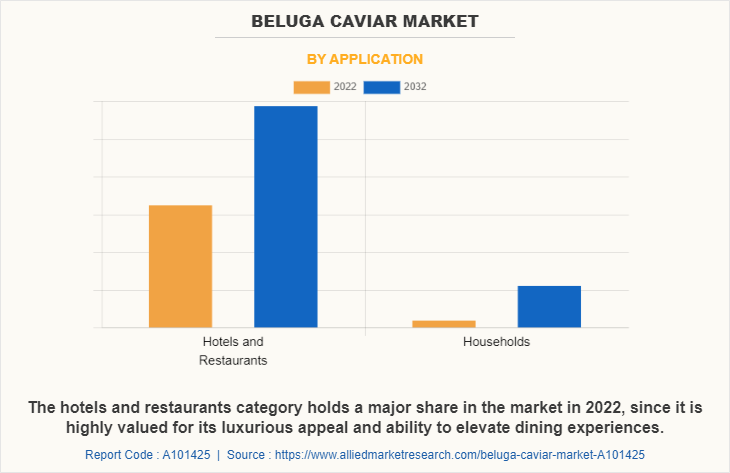
By Distribution Channel
According to the beluga caviar market demand, on the basis of distribution channel, the market is bifurcated into direct and indirect distribution channel. The direct segment dominated the market in 2022 and is expected to maintain its dominance during the forecast period since it provides advantages to producers and consumers both. It allows producers to capture a larger portion of the market value by eliminating the margins typically associated with intermediaries. The rising consumer need for transparency, technological advancements, the desire to enjoy a distinct culinary experience, and the chance for better value proposition on both the producer and customer side are likely to drive the direct distribution channel of beluga caviar even further.
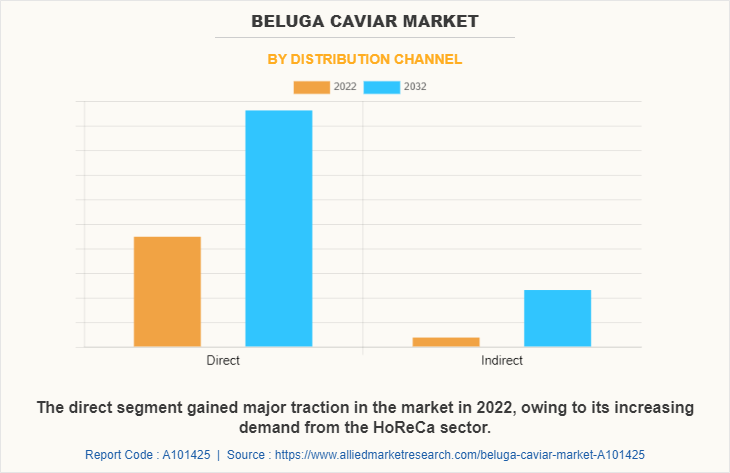
By Region
Region-wise the beluga caviar market is analyzed across North America (U.S., Canada, Mexico), Europe (UK, Germany, France, Italy, Spain, and the rest of Europe), Asia-Pacific (China, Japan, India, Australia, and the rest of Asia-Pacific) and LAMEA (Latin America, Middle East, and Africa). Europe accounted for the majority of the share of the market and is expected to maintain its dominance during the beluga caviar market forecast period owing to factors such as the region's cultural connection to caviar, its diverse culinary landscape, sustainable fishing practices, the influence of the tourism industry, technological advancements in e-commerce, and the European market's appreciation for authenticity. With a combination of tradition, sustainability, accessibility, and market demand, the European market presents significant growth opportunities for the beluga caviar market.
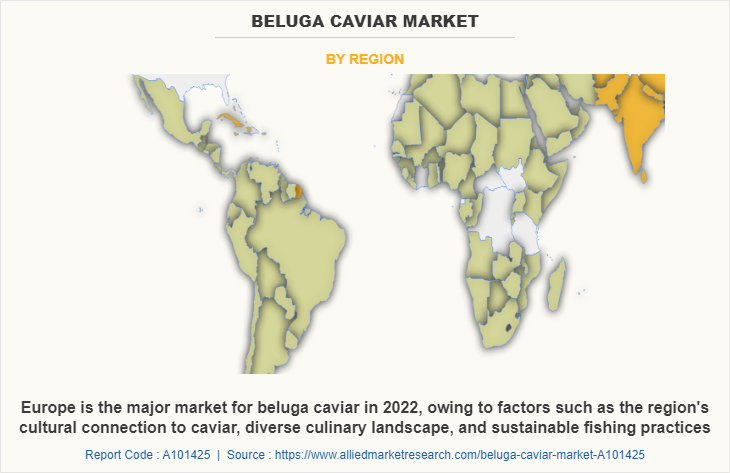
Players operating in the global beluga caviar market have adopted various developmental strategies to expand their beluga caviar market share, increase profitability, and remain competitive in the market. Key players profiled in this report include 8 Gems Pte Ltd., Caviar India Inc., La Maison Nordique, Attilus GmbH, Imperial Beluga Caviar Inc., Petrossian Inc., Russian Caviar House LLP, Caviar De Beluga Ltd., Caviar House And Prunier (Switzerland) SA, Lemberg Lebensmittel GmbH.
Some Examples of Product Launch in The Market
In September 2022, Petrossian Inc., expanded its business presence in South Kensington, UK, with launch of new restaurant.
In October 2021, Petrossian Inc., opened new caviar lab in Chessington, UK. With this new lab it will expand its business operation in the caviar product line.
In July 2021, Caviar House & Prunier (Switzerland) SA received investment from OLMA Luxury Holdings. With this investment it will expand its focus on food development and distribution.
Key Benefits For Stakeholders
- This report provides a quantitative analysis of the market segments, current trends, estimations, and dynamics of the beluga caviar market analysis from 2022 to 2032 to identify the prevailing beluga caviar market opportunities.
- The market research is offered along with information related to key drivers, restraints, and opportunities.
- Porter's five forces analysis highlights the potency of buyers and suppliers to enable stakeholders make profit-oriented business decisions and strengthen their supplier-buyer network.
- In-depth analysis of the beluga caviar market segmentation assists to determine the prevailing market opportunities.
- Major countries in each region are mapped according to their revenue contribution to the global market.
- Market player positioning facilitates benchmarking and provides a clear understanding of the present position of the market players.
- The report includes the analysis of the regional as well as global beluga caviar market trends, key players, market segments, application areas, and market growth strategies.
Beluga Caviar Market Report Highlights
| Aspects | Details |
| Market Size By 2032 | USD 179.4 million |
| Growth Rate | CAGR of 5.1% |
| Forecast period | 2022 - 2032 |
| Report Pages | 202 |
| By Form |
|
| By Application |
|
| By Distribution Channel |
|
| By Region |
|
| Key Market Players | Imperial Beluga Caviar Inc., Caviar De Beluga Ltd., Lemberg Lebensmittel GmbH, 8 Gems Pte Ltd., Petrossian Inc., Caviar India Inc., Russian Caviar House LLP, Caviar House & Prunier (Switzerland) SA, Attilus GmbH, La Maison Nordique |
Analyst Review
According to the insights of the top-level CXOs, the beluga caviar market has witnessed steady growth even under major challenges such as global uncertainty, falling fish stocks, and environmental issues. The growth of this sector is attributed to an increase in awareness of health benefits associated with seafood and changes in the lifestyle of consumers.
The CXOs further added that Asia-Pacific is expected to witness robust growth during the forecast period. This is attributed to the fact that the market in this region is undergoing a transition in terms of consumer preferences and buying patterns, with higher preference seen for healthy food options that are rich in proteins, vitamins, and other nutrients over the previously widely preferred fast foods.
The global beluga caviar market size was valued at $108.4 million in 2022, and is projected to reach $179.4 million by 2032
The global Beluga Caviar market is projected to grow at a compound annual growth rate of 5.1% from 2023 to 2032 $179.4 million by 2032
Key players profiled in this report include 8 Gems Pte Ltd., Caviar India Inc., La Maison Nordique, Attilus GmbH, Imperial Beluga Caviar Inc., Petrossian Inc., Russian Caviar House LLP, Caviar De Beluga Ltd., Caviar House And Prunier (Switzerland) SA, Lemberg Lebensmittel GmbH.
Europe accounted for the majority of the share of the market
Exclusivity and Luxury Appeal, Diversification and Hybrid Caviar, Growing Culinary Tourism
Loading Table Of Content...
Loading Research Methodology...


